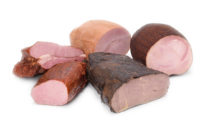Phosphates are used in a variety of meat and poultry products for a number of reasons, including as processing aids and functional ingredients. The most common categories of products that use phosphates are cooked sausages, hams and other whole-muscle products where moisture retention is important. Phosphates are used in these types of products to increase the meat system pH to improve water-holding capacity, says Jeff Sindelar, associate professor in the department of animal science at the University of Wisconsin-Madison.
“The main functionality is to change the meat system pH, so that we are moving the pH of the meat further away from the isometric point,” he explains. “The isometric point of meat is around 5.2 to 5.3. By adding phosphates, we are adding additional charges to the meat system. Because of that, you are creating an imbalance between positive and negative charges, so you are changing basically the ionic strength in the meat system. You are causing the proteins to push away or swell, and because of that, you create more space for the protein charges that can grab onto water and bind water. This is also essentially the same mechanism of cooked sausages, which is where phosphates can help with protein extraction, and they do so by kind of the same type of mechanism.”
On the other hand, phosphates are sometimes used in products, such as cured meat, to reduce the pH.
“When a slight pH reduction occurs in certain meat systems, products where cured meat color is important is benefitted because a slight pH reduction can increase important curing reactions,” Sindelar says. “Those products are typically the ones where yield is not a concern.”
In other products, phosphates are used to improve texture, Sindelar says. In the case of bacon, phosphates are added to help control bacon splatter during cooking by the consumer, he adds.
Roger Clemens, adjunct professor of pharmacology and pharmaceutical sciences at the University of Southern California, Los Angeles, says phosphates serve three basic functions when it comes to food systems: buffering pH, acting as emulsifiers and stabilizing.
“It’s important to look at those three functions,” he says. “The bottom line is, all of those, they help to stabilize a product whatever the finished product might be.”
He provides the example of extruded chicken, which might include some extra parts to help minimize waste causing the product to not look as pleasing. “Phosphates actually help to minimize waste, so we can use edible product in what is perhaps in some form that is not appealing, but in other forms is quite appealing,” Clemens explains.
The use of phosphates also has evolved over the years. For example, fresh meat and poultry products are growing leaner than they were several decades ago because of changes in how animals are being produced, says Kantha Shelke, food scientist and principal of Corvus Blue LLC, Chicago. While the lower levels of fat may be desirable for the nutritional profile, flavor and texture suffer because fat contributes flavor and moistness and also some room for error if overcooked, as leaner meats are easily overcooked, she explains. Phosphates, hence, are being used to help replace flavor and moisture and to help leaner cuts with temperature abuse, she says.
In addition, phosphates help with manufacturing economics by opening up muscle structure and increasing sites for moisture binding, Shelke says.
Versatile ingredient,
difficult to replace
The usage level for phosphates — sodium and/or potassium — in finished meat and poultry products is limited to 0.5 percent; however, phosphates are rarely used at a maximum level. The use of phosphates is somewhat stable, Sindelar says. Phosphates remain popular because of how they work and the effects they have.
“There are a lot of other binders and extenders that are effective and have been researched over the years, from vegetable proteins to starches and gums and so forth, and although some of those products are used today, the primary ingredient most commonly used for improving water-holding capacity and helping with protein extraction, which improves bind and helps even with texture, are phosphates because they work so well,” Sindelar says. “They are relatively inexpensive, so they are very competitive. They focus on the biochemical aspect of the meat system, which is affecting the protein itself and changing how that protein performs and interacts with other proteins and other ingredients, water and fat and so forth. Few other binders or extenders really function that way. Really, no ingredient acts the way that phosphates do. There are some that are close, but phosphates are just very unique in their mechanism and the measurable effect that they have on products. Of course, price also becomes very, very helpful in that conversation.”
While phosphates have been used for a number of decades, their use took a dip with the growth of clean-label processing, particularly because phosphates are not allowed in products labeled natural. Many organizations, companies and universities are looking for alternatives for the use of phosphates, and typically those types of ingredients would be coming from plant sources, Clemens says. Phosphates come from the ground, and they can be synthesized in a test tube on a larger scale, he says.
“The bottom issue is to find alternatives that, in fact, function as emulsifiers and buffers, and that’s very difficult, frankly,” Clemens says. “You need to understand a lot of chemistry both as emulsifiers and buffering solutions so that you maintain optimal pH and minimize antimicrobial growth. … It’s trying to keep clean label, so that its functionality is simple, but right now, the chemistry is not so simple.”
Sindelar thinks more processors are starting to use phosphates again just because of the sheer benefits of using them and the challenges associated with trying to replace them, whether it be matching performance or cost.
“Phosphates have kind of made it back onto some of those ingredient labels that perhaps you would consider to be more clean-label probably because they are ingredients that are one of those tweener ingredients from a consumer acceptability standpoint,” Sindelar says. “Consumers may not know what they are, but they see them on a lot of other food product labels so that they are not completely obscure to them.”
Some processors are using potassium phosphates so their products qualify for low-sodium labeling as well. The amount of potassium phosphates added to sodium-reduced meat products may be dangerous for patients with kidney disease, though, Shelke says. Because individuals with kidney dysfunction must maintain diets low in phosphorus and potassium, it’s unclear whether sodium-reduced phosphate-enhanced meat and poultry foods are safe for these patients, she says. As such, a growing call has arisen from many dietitians to list phosphates or phosphorus on the label, Clemens says. Currently, neither is required by law.
Highly useable
The main challenges of using phosphates aren’t difficult to overcome or prevent. One of the biggest challenges has just been incorporating them as an ingredient. Phosphates typically have a lower solubility compared to a salt or sugar, so it’s harder to get them into a solution, Sindelar explains. Phosphate manufacturers have addressed that by making blends of phosphates, because different types of phosphates have different solubilities, he says. For example, if a processor uses straight sodium tripolyphosphate, it is a little more difficult to dissolve into water versus a mixed phosphate, which might include sodium hexametaphosphate.
Phosphates also can run into issues in terms of their functionality if they are not handled correctly after they are added to a meat product, Sindelar says. For example, long holding times after phosphates are added to a product can cause problems in which a processor actually can lose the phosphate functionality. A great example is poultry, Sindelar says.
“If you add a brine that includes phosphates and you hold that poultry before it’s cooked, for example, for more than 12 to 24 hours, you can actually lose a significant amount of the functionality of those phosphates,” he explains.
The key is making sure to use the correct phosphate.
“There are several phosphates that are approved and several ones that are used in different blends,” Sindelar says. “You need to make sure you are using the right one for the right product, whether you are trying to focus on protein extraction or cured meat color or water-holding capacity or improved slicing yield and making sure you are incorporating the phosphate effectively into a product or into a brine so you have the maximum use for it and that you are making sure that you are getting the most function from the phosphate for the product to which it is added.”






Report Abusive Comment